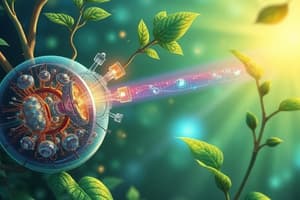Podcast
Questions and Answers
What is the optimum temperature for photosynthesis according to the experiment?
What is the optimum temperature for photosynthesis according to the experiment?
- 30°C
- 35°C
- 25°C (correct)
- 20°C
In the experiment, increasing the light intensity decreases the rate of photosynthesis.
In the experiment, increasing the light intensity decreases the rate of photosynthesis.
False (B)
What limiting factor is addressed in the experiment to ensure enough carbon dioxide is available?
What limiting factor is addressed in the experiment to ensure enough carbon dioxide is available?
CO2
The process of photosynthesis is anabolic, converting ______ into energy-rich glucose.
The process of photosynthesis is anabolic, converting ______ into energy-rich glucose.
Match the following processes in photosynthesis with their descriptions:
Match the following processes in photosynthesis with their descriptions:
What is the main product of cyclic photophosphorylation?
What is the main product of cyclic photophosphorylation?
In non-cyclic photophosphorylation, electrons are not replaced after they leave the chlorophyll.
In non-cyclic photophosphorylation, electrons are not replaced after they leave the chlorophyll.
What process breaks down water molecules to provide electrons in non-cyclic photophosphorylation?
What process breaks down water molecules to provide electrons in non-cyclic photophosphorylation?
The electrons ejected from chlorophyll during cyclic photophosphorylation return to the ______.
The electrons ejected from chlorophyll during cyclic photophosphorylation return to the ______.
Match the type of photophosphorylation with its characteristics:
Match the type of photophosphorylation with its characteristics:
Which of the following statements is true about the electron transport chain in cyclic photophosphorylation?
Which of the following statements is true about the electron transport chain in cyclic photophosphorylation?
High-energy electrons produced in non-cyclic photophosphorylation are used in the light-independent reactions.
High-energy electrons produced in non-cyclic photophosphorylation are used in the light-independent reactions.
What gas is produced as a byproduct of non-cyclic photophosphorylation?
What gas is produced as a byproduct of non-cyclic photophosphorylation?
What molecule is produced when NADP picks up electrons and a hydrogen ion?
What molecule is produced when NADP picks up electrons and a hydrogen ion?
In cyclic photophosphorylation, the electron removed from chlorophyll returns back to it.
In cyclic photophosphorylation, the electron removed from chlorophyll returns back to it.
What is the main product of the light-independent stage when hydrogen ions and CO2 combine?
What is the main product of the light-independent stage when hydrogen ions and CO2 combine?
ATP is formed from ADP and a ______.
ATP is formed from ADP and a ______.
Which process does not return the electron to chlorophyll?
Which process does not return the electron to chlorophyll?
The energy for glucose formation in the light-independent stage primarily comes from NADPH.
The energy for glucose formation in the light-independent stage primarily comes from NADPH.
Match the following terms with their correct descriptions:
Match the following terms with their correct descriptions:
What molecule is regenerated after NADPH delivers hydrogen ions?
What molecule is regenerated after NADPH delivers hydrogen ions?
Flashcards are hidden until you start studying
Study Notes
Light-dependent Stage: Cyclic and Non-Cyclic Photophosphorylation
- Cyclic Photophosphorylation: Electrons energised from chlorophyll return to the chlorophyll after passing through the electron transport chain, losing energy and producing ATP.
- Electron Transport Chain: High-energy electrons released from chlorophyll are accepted by an electron acceptor, which transmits them along the chain, generating ATP.
- Non-Cyclic Photophosphorylation: Electrons leave chlorophyll and are replaced by electrons from photolysis of water, resulting in oxygen production and ATP synthesis for glucose formation.
- Photolysis of Water: This process breaks down water to provide high-energy electrons and produce oxygen, which can be used in respiration or released into the atmosphere.
- Proton Pool: Hydrogen ions from photolysis enter a proton pool, contributing to glucose synthesis in the light-independent stage.
Formation of NADPH
- NADP Reduction: Electrons from chlorophyll and hydrogen from the proton pool combine with NADP to form NADPH, which transports hydrogen to the light-independent stage.
Light-independent Stage (Calvin Cycle)
- Carbon Dioxide Uptake: CO2 diffuses into the stroma, where it is converted into glucose using electrons and hydrogen from NADPH.
- ATP Role: Energy for glucose formation is supplied by ATP produced in the light-dependent stage.
- NADPH Recycle: Once it delivers its electrons and protons, NADPH is converted back to NADP°, ready to participate again.
Experimental Investigation of Photosynthesis
- Method: Set up and adjust distance from a light source to elodea. Record oxygen bubble production after 3 minutes of acclimation at varied distances.
- Results and Conclusion: Closer light increases oxygen bubble production, indicating a direct relationship between light intensity and the rate of photosynthesis.
- Temperature Monitoring: Maintaining an optimal temperature (approximately 25°C) is crucial as photosynthesis is enzyme-driven.
- Sodium Bicarbonate: Ensures CO2 availability, preventing it from becoming a limiting factor.
Limiting Factors in Photosynthesis
- Definition: Limiting factors are conditions that restrain the growth of a population, such as CO2 levels in the experiment.
- Enhancing Growth in Greenhouses: CO2 enrichment and artificial lighting can optimize photosynthesis.
Variables Affecting Photosynthesis
- Key Variables: Light intensity, CO2 concentration, and temperature, all of which impact the photosynthetic rate.
- Anabolism in Photosynthesis: Photosynthesis is an anabolic process, converting small molecules into larger ones (e.g., from CO2 to glucose).
Reason for Using Aquatic Plants
- Aquatic setups allow for the observation of visible oxygen bubble production, facilitating accurate measurement of photosynthesis rates.
Studying That Suits You
Use AI to generate personalized quizzes and flashcards to suit your learning preferences.




